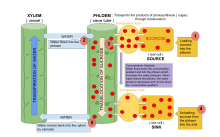**Stem Structure and Function:**
– The stem consists of dermal, ground, and vascular tissues.
– Dermal tissue covers the outer surface for protection and gas exchange.
– Ground tissue contains parenchyma cells and may function in photosynthesis.
– Vascular tissue provides long-distance transport and support.
– Functions of the stem include support for leaves, flowers, and fruits, transport of fluids, storage of nutrients, production of new tissue through meristems, and photosynthesis.
**Types of Stems:**
– Acaulescent stems appear stemless.
– Arborescent stems are woody with a single trunk.
– Climbing stems cling or wrap around structures.
– Corm and rhizome are underground storage stems.
– Scape stems hold flowers without normal leaves.
– Woody stems have a hard texture with secondary xylem.
**Xylem and Phloem in Stems:**
– Xylem transports water through various mechanisms.
– Phloem distributes food from photosynthetic tissue.
– Cambium divides to form xylem or phloem cells.
– Xylem and phloem are separated by cambium tissue.
– Gymnosperms produce tracheids in xylem and contain resin ducts.
**Stem Types in Different Plant Groups:**
– Dicot stems have primary growth with pith and visible vascular bundles.
– Monocot stems have vascular bundles throughout and rarely produce secondary growth.
– Gymnosperm stems are woody and contain resin ducts.
– Fern stems may have rhizomes or vertical stems with complex anatomy.
– Palms and bamboo are exceptions to non-woody monocots.
**Economic Importance and Impact of Xenobiotics:**
– Stems of thousands of species have economic uses.
– Sugarcane stems are a major source of sugar.
– Wood from stems is used in various industries.
– Foreign chemicals like air pollutants can harm stem structures.
– Herbicides and pesticides can also negatively impact stems.
This article needs additional citations for verification. (March 2022) |
A stem is one of two main structural axes of a vascular plant, the other being the root. It supports leaves, flowers and fruits, transports water and dissolved substances between the roots and the shoots in the xylem and phloem, photosynthesis takes place here, stores nutrients, and produces new living tissue. The stem can also be called halm or haulm or culms.



The stem is normally divided into nodes and internodes:
- The nodes are the points of attachment for leaves and can hold one or more leaves. There are sometimes axillary buds between the stem and leaf which can grow into branches (with leaves, conifer cones, or flowers). Adventitious roots may also be produced from the nodes. Vines may produce tendrils from nodes.
- The internodes distance one node from another.
The term "shoots" is often confused with "stems"; "shoots" generally refers to new fresh plant growth, including both stems and other structures like leaves or flowers.
In most plants, stems are located above the soil surface, but some plants have underground stems.
Stems have several main functions:
- Support for and the elevation of leaves, flowers, and fruits. The stems keep the leaves in the light and provide a place for the plant to keep its flowers and fruits.
- Transport of fluids between the roots and the shoots in the xylem and phloem.
- Storage of nutrients.
- Production of new living tissue. The normal lifespan of plant cells is one to three years. Stems have cells called meristems that annually generate new living tissue.
- Photosynthesis.
Stems have two pipe-like tissues called xylem and phloem. The xylem tissue arises from the cell facing inside and transports water by the action of transpiration pull, capillary action, and root pressure. The phloem tissue arises from the cell facing outside and consists of sieve tubes and their companion cells. The function of phloem tissue is to distribute food from photosynthetic tissue to other tissues. The two tissues are separated by cambium, a tissue that divides to form xylem or phloem cells.
